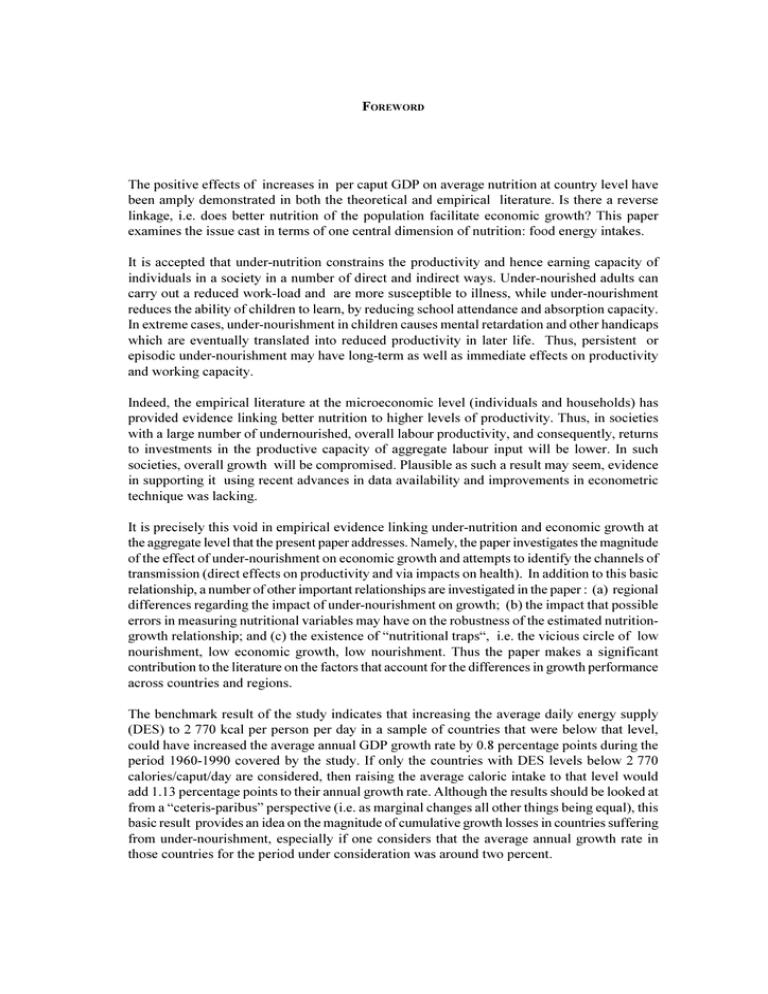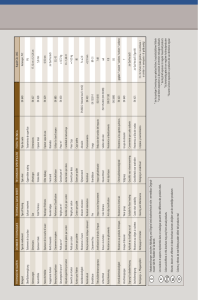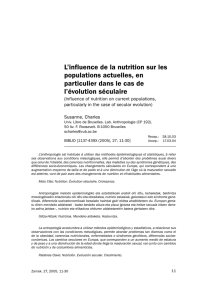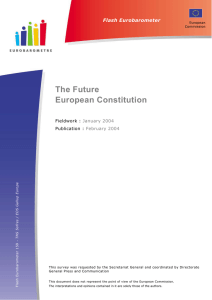The positive effects of increases in per caput GDP on average
Anuncio

FOREWORD The positive effects of increases in per caput GDP on average nutrition at country level have been amply demonstrated in both the theoretical and empirical literature. Is there a reverse linkage, i.e. does better nutrition of the population facilitate economic growth? This paper examines the issue cast in terms of one central dimension of nutrition: food energy intakes. It is accepted that under-nutrition constrains the productivity and hence earning capacity of individuals in a society in a number of direct and indirect ways. Under-nourished adults can carry out a reduced work-load and are more susceptible to illness, while under-nourishment reduces the ability of children to learn, by reducing school attendance and absorption capacity. In extreme cases, under-nourishment in children causes mental retardation and other handicaps which are eventually translated into reduced productivity in later life. Thus, persistent or episodic under-nourishment may have long-term as well as immediate effects on productivity and working capacity. Indeed, the empirical literature at the microeconomic level (individuals and households) has provided evidence linking better nutrition to higher levels of productivity. Thus, in societies with a large number of undernourished, overall labour productivity, and consequently, returns to investments in the productive capacity of aggregate labour input will be lower. In such societies, overall growth will be compromised. Plausible as such a result may seem, evidence in supporting it using recent advances in data availability and improvements in econometric technique was lacking. It is precisely this void in empirical evidence linking under-nutrition and economic growth at the aggregate level that the present paper addresses. Namely, the paper investigates the magnitude of the effect of under-nourishment on economic growth and attempts to identify the channels of transmission (direct effects on productivity and via impacts on health). In addition to this basic relationship, a number of other important relationships are investigated in the paper : (a) regional differences regarding the impact of under-nourishment on growth; (b) the impact that possible errors in measuring nutritional variables may have on the robustness of the estimated nutritiongrowth relationship; and (c) the existence of nutritional traps, i.e. the vicious circle of low nourishment, low economic growth, low nourishment. Thus the paper makes a significant contribution to the literature on the factors that account for the differences in growth performance across countries and regions. The benchmark result of the study indicates that increasing the average daily energy supply (DES) to 2 770 kcal per person per day in a sample of countries that were below that level, could have increased the average annual GDP growth rate by 0.8 percentage points during the period 1960-1990 covered by the study. If only the countries with DES levels below 2 770 calories/caput/day are considered, then raising the average caloric intake to that level would add 1.13 percentage points to their annual growth rate. Although the results should be looked at from a ceteris-paribus perspective (i.e. as marginal changes all other things being equal), this basic result provides an idea on the magnitude of cumulative growth losses in countries suffering from under-nourishment, especially if one considers that the average annual growth rate in those countries for the period under consideration was around two percent. iv The paper also suggests the existence of nutritional growth traps. The mean growth rate of countries having low levels of food inadequacy is about three times as high as the mean growth rates in countries with high levels of food inadequacy. A very important implication of the study, for developing country governments and donors alike, is that policies (including development aid) which reduce or eliminate under-nourishment in developing countries should not be viewed only in terms of their welfare and humanitarian benefits, but also in terms of their growth-promoting dimensions. It is also hoped that by publishing the present paper, FAO opens an important debate on the short- and long-term implications of poverty and hunger for the overall development effort. Jacques Vercueil Director Agriculture and Economic Development Analysis Division v CONTENTS page ABSTRACT RÉSUMÉ RESUMEN ABSTRACT (ARABIC) 1 2 3 4 1. BASIC EMPIRICAL REGULARITIES 1.1 Introduction 1.2 Stylized facts 1.3 Malnutrition and endogenous growth 1.4 Malnutrition within a neo-classical framework 1.5 Non-linearities and threshold effects 5 5 9 11 12 13 2. ROBUSTNESS 2.1 The Svedberg critique, unobserved, country-specific heterogeneity, and random measurement error 2.2 Sensitivity to data structure 19 3. TRANSMISSION MECHANISMS 3.1 Direct versus indirect transmission mechanisms 3.2 Life expectancy 3.3 Schooling 27 27 28 30 4. CONDITIONAL RESPONSE 4.1 Nutritional growth traps ? 4.2 Empirical specification 4.3 Escaping the malnutrition trap: some tentative findings 33 33 35 39 5. ENDOGENEITY AND STRUCTURAL ESTIMATION 5.1 Life expectancy 5.2 Schooling 41 41 47 6. THE EFFICIENCY COST OF HUNGER: A QUANTITATIVE ASSESSMENT 51 7. CONCLUDING REMARKS 55 REFERENCES 57 19 22 vi ACKNOWLEDGEMENT I wish to express my thanks to Kostas Stamoulis, Jacques Vercueil, Willi Meyers, Ali Gürkan, Barbara Huddleston and Kiyoshi Taniguchi for comments that significantly improved a previous version of the paper, as well as participants in the FAO ESA seminar for constructive criticisms. All sins of omission or commission are, of course, my own. 1 ABSTRACT This paper considers the impact of two measures of nutritional status on the growth rate of GDP per caput: the prevalence of food inadequacy (PFI), and the dietary energy supply (DES) per caput, as reported by the FAO in the Sixth World Food Survey. A surprisingly strong relationship appears to link economic growth to nutritional factors, and is robust to econometric procedures that correct for unobserved, country-specific heterogeneity, as well as measurement error or endogeneity concerns raised by the recent critique of FAO data by Svedberg (1999). The impact of nutrition on economic growth would appear to operate directly, through nutritions effect on labour productivity, as well as indirectly, through improvements in life expectancy. Depending upon the empirical specification that is chosen, the point estimates imply that inadequate nutrition is responsible for a shortfall of between 0.23 and 4.7 percentage points in the annual growth rate of GDP per caput worldwide, with the higher figure, ironically, corresponding to estimation techniques that correct for the data problems identified by Svedberg. Aside from its effect on human welfare, the efficiency cost of hunger would therefore appear to be extremely important. Even when allowing for substantial overestimation of the PFI or underestimation of the DES per caput for sub-Saharan Africa, the results provide a compelling explanation for the growth shortfall suffered by the African continent, with estimates ranging from 0.16 percentage points to 4.0 percentage points of lost growth. Seen from another angle, countries with above-median PFI would have seen their annual growth rate of GDP per caput increase by 1.6 percentage points if they had raised their DES per caput to 2,770 kcal / day. However one looks at the problem, achieving the goal of reducing the prevalence of food inadequacy by half by 2015, as enunciated at the World Food Summit of 1996, would therefore not only improve human welfare considerably, but also substantially increase the rate of economic growth. Résumé Dans ce document, j'examine le rapport entre le taux de croissance du PIB par habitant et deux mesures de l'état nutritionnel: la prévalence de l'insuffisance alimentaire et la disponibilité énergétique alimentaire par habitant, tels qu'établies par la FAO dans la Sixième enquête mondiale sur l'alimentation. Il semble qu'il existe un lien extrêmement étroit entre la croissance économique et les facteurs nutritionnels, quelles que soient les procédures économétriques destinées à apporter des corrections en cas d'hétérogénéité spécifique nationale non observée, ainsi qu'aux préoccupations concernant des erreurs de mesure ou des cas possibles d'endogénéité soulevées par les critiques récentes des données FAO par Svedberg (1999). Les effets de la nutrition sur la croissance économique se font directement sentir au niveau de la productivité du travail, et indirectement, grâce aux progrès de l'espérance de vie. Selon la spécification empirique retenue, mes estimations ponctuelles font apparaître qu'une nutrition inadéquate est responsable d'un déficit compris entre 0,23 et 4,7 points de pourcentage du taux de croissance annuel du PIB par habitant dans le monde, le chiffre le plus élevé résultant, il convient de le relever, de techniques d'estimation conçues pour corriger les problèmes de données relevés par Svedberg. Mis à part les effets sur les conditions de vie, le coût de la faim du point de vue de l'efficience semblerait donc extrêmement important. Même si l'on tient compte d'une éventuelle surestimation importante de la prévalence de l'insuffisance alimentaire ou d'une sous-estimation de la disponibilité énergétique alimentaire par habitant en Afrique subsaharienne, mes calculs expliquent de manière convaincante le déficit de croissance que connaît le continent africain, les estimations allant de 0,16 point de pourcentage à 4,0 points de pourcentage de croissance perdue. Sous un autre angle, les pays dont la prévalence de l'insuffisance alimentaire est supérieure à la médiane auraient enregistré une augmentation du taux de croissance annuel de leur PIB par habitant de 1,6 point de pourcentage s'ils avaient porté les disponibilités énergétiques alimentaires par habitant à 2 770 kcal/jour. Quelle que soit la façon dont on examine le problème, la réduction de moitié de la prévalence de l'insuffisance alimentaire pour 2015 au plus tard, objectif déclaré du Sommet mondial de l'alimentation en 1996, permettrait non seulement de beaucoup améliorer les conditions de vie, mais aussi d'augmenter considérablement le taux de croissance économique. Resumen En el presente documento se examinan los efectos sobre la tasa de crecimiento del PIB per cápita que tienen dos mediciones del estado nutricional, a saber la prevalencia de la insuficiencia de alimentos (PIA) y el suministro de energía alimentaria (SEA), según informa la FAO en la Sexta Encuesta Alimentaria Mundial. Parece haber una relación asombrosamente estrecha entre el crecimiento económico y los factores nutricionales, relación que es resistente a los procedimientos econométricos orientados a corregir la heterogeneidad no observada específica de los países, así como errores de medición o las preocupaciones con respecto a la endogeneidad que se plantean en la crítica de los datos de la FAO realizada recientemente por Svedberg (1999). Al parecer, las consecuencias de la nutrición para el crecimiento económico son tanto directas, mediante los efectos de la nutrición sobre la productividad de la mano de obra, como indirectas, mediante las mejoras en la esperanza de vida. Según la especificación empírica que se elija, mis estimaciones puntuales implican que una nutrición insuficiente es la causa de una reducción de la tasa anual de crecimiento del PIB per cápita en todo el mundo comprendida entre el 0,23 y el 4,7 por ciento, correspondiendo irónicamente la cifra más alta a las técnicas de estimación que corrigen los problemas de datos indicados por Svedberg. Además de sus efectos sobre el bienestar humano, el costo de eficiencia del hambre parece ser sumamente importante. Aun teniendo en cuenta la posibilidad de una estimación muy excesiva de la PIA o una estimación insuficiente del SEA per cápita para el África subsahariana, mis resultados ofrecen una explicación convincente del déficit de desarrollo sufrido por el continente africano, variando las estimaciones del crecimiento no registrado entre el 0,16 y el 4,0 por ciento. Examinando la cuestión desde otro punto de vista, si los países con una PIA superior a la mediana hubieran aumentado su SEA per cápita hasta 2 770 kcal/día, se habría observado un aumento del 1,6 por ciento de su tasa anual de crecimiento del PIB per capita. Por consiguiente, comoquiera que se considere el problema, el logro del objetivo de reducir a la mitad la prevalencia de la insuficiencia de alimentos para el año 2015, enunciado en la Cumbre Mundial sobre la Alimentación de 1996, no sólo mejoraría notablemente el bienestar humano, si no que además aumentaría considerablemente la tasa de crecimiento económico.




